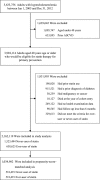Time- and Dose-Dependent Association of Statin Use With Risk of Clinically Relevant New-Onset Diabetes Mellitus in Primary Prevention: A Nationwide Observational Cohort Study
- PMID: 30982384
- PMCID: PMC6507181
- DOI: 10.1161/JAHA.118.011320
Time- and Dose-Dependent Association of Statin Use With Risk of Clinically Relevant New-Onset Diabetes Mellitus in Primary Prevention: A Nationwide Observational Cohort Study
Abstract
Background Given that statins are increasingly being used for primary-prevention, the public concerns regarding the risk of new-onset diabetes mellitus associated with statin use may be an issue. Methods and Results Using healthcare data from the national health insurance examinees, our study comprised a cohort of adults aged ≥40 years with hypercholesterolemia who would be eligible for statin therapy for primary prevention from 2005 to 2012. The primary outcome was the occurrence of clinically relevant new-onset diabetes mellitus requiring medical therapy. Among 2 162 119 adults with hypercholesterolemia who might be eligible for statin therapy, 638 625 (29.5%) ever used statins and 1 523 494 (70.5%) never used statins. In the propensity-matched cohort of 518 491 pairs, during mean follow-up of 3.9 years, being an ever-user of statin was significantly associated with diabetes mellitus risk compared with being a never-user of statin (13.4 versus 6.9 per 1000 person-years; adjusted hazard ratio [ HR ], 1.88; 95% CI , 1.85-1.93). With increasing duration of statin use, the risk of diabetes mellitus was proportionally increased ( HR 1.25 <1 year, HR 2.22 for 1-2 years, and HR 2.62 >2 years). An excess risk of diabetes mellitus was also associated with a higher intensity ( HR 1.75 for low-to-moderate potency and HR 2.31 for high potency) and a cumulative dosing of statin ( HR 1.06 for low-tertile, HR 1.74 for middle-tertile, and HR 2.52 for high-tertile of defined-daily-disease). Conclusions In patients receiving statin therapy for primary prevention, there was a time- and dose-dependent association of statin use with an increasing risk of new-onset diabetes mellitus.
Keywords: diabetes mellitus; hypercholesterolemia; statin.
Figures




Comment in
-
Perils of Observational Data Analyses.J Am Heart Assoc. 2019 Apr 16;8(8):e012490. doi: 10.1161/JAHA.119.012490. J Am Heart Assoc. 2019. PMID: 30982393 Free PMC article.
References
-
- Collins R, Reith C, Emberson J, Armitage J, Baigent C, Blackwell L, Blumenthal R, Danesh J, Smith GD, DeMets D, Evans S, Law M, MacMahon S, Martin S, Neal B, Poulter N, Preiss D, Ridker P, Roberts I, Rodgers A, Sandercock P, Schulz K, Sever P, Simes J, Smeeth L, Wald N, Yusuf S, Peto R. Interpretation of the evidence for the efficacy and safety of statin therapy. Lancet. 2016;388:2532–2561. - PubMed
-
- Stone NJ, Robinson JG, Lichtenstein AH, Bairey Merz CN, Blum CB, Eckel RH, Goldberg AC, Gordon D, Levy D, Lloyd‐Jones DM, McBride P, Schwartz JS, Shero ST, Smith SC Jr, Watson K, Wilson PW, Eddleman KM, Jarrett NM, LaBresh K, Nevo L, Wnek J, Anderson JL, Halperin JL, Albert NM, Bozkurt B, Brindis RG, Curtis LH, DeMets D, Hochman JS, Kovacs RJ, Ohman EM, Pressler SJ, Sellke FW, Shen WK, Smith SC Jr, Tomaselli GF. 2013 ACC/AHA guideline on the treatment of blood cholesterol to reduce atherosclerotic cardiovascular risk in adults: a report of the American College of Cardiology/American Heart Association Task Force on Practice Guidelines. Circulation. 2014;129:S1–S45. - PubMed
-
- Betteridge DJ, Carmena R. The diabetogenic action of statins—mechanisms and clinical implications. Nat Rev Endocrinol. 2016;12:99–110. - PubMed
-
- Ridker PM, Danielson E, Fonseca FA, Genest J, Gotto AM Jr, Kastelein JJ, Koenig W, Libby P, Lorenzatti AJ, MacFadyen JG, Nordestgaard BG, Shepherd J, Willerson JT, Glynn RJ. Rosuvastatin to prevent vascular events in men and women with elevated C‐reactive protein. N Engl J Med. 2008;359:2195–2207. - PubMed
Publication types
MeSH terms
Substances
LinkOut - more resources
Full Text Sources
Medical

